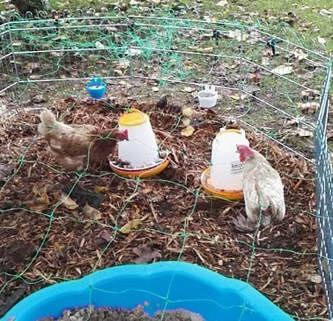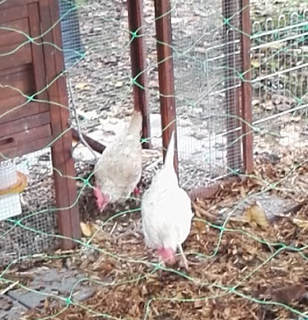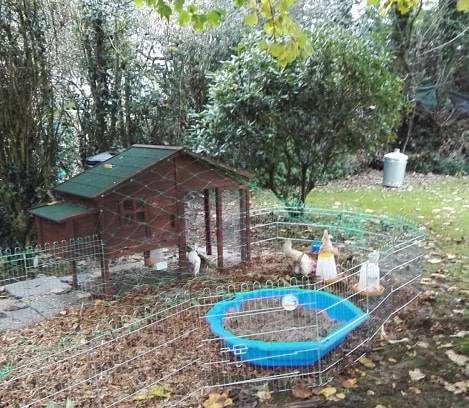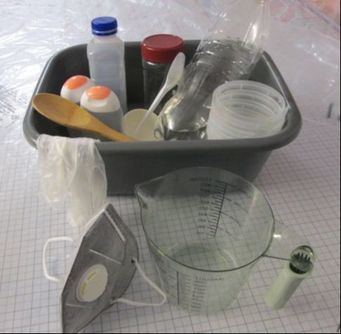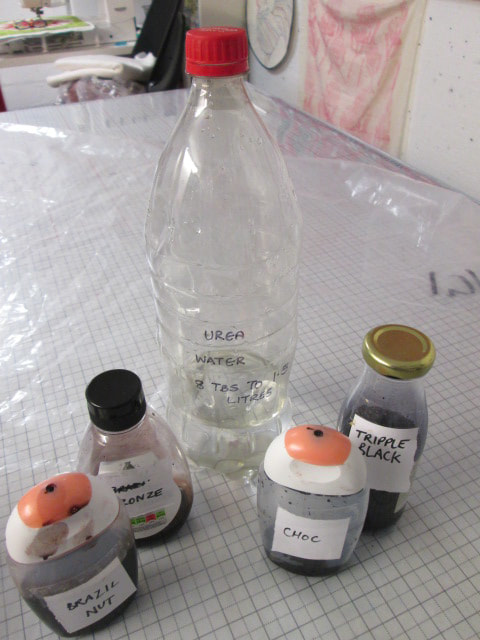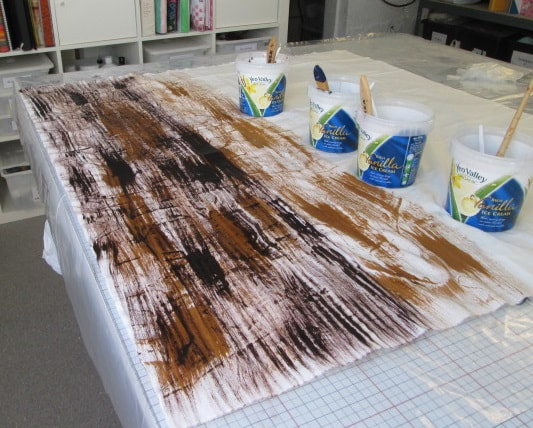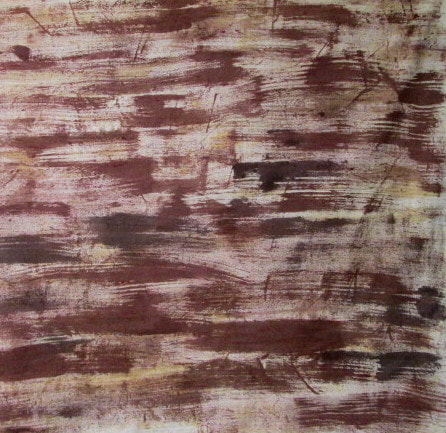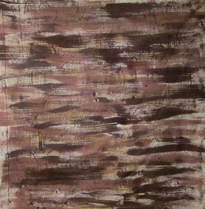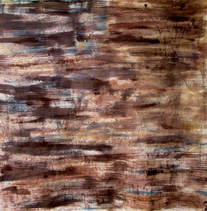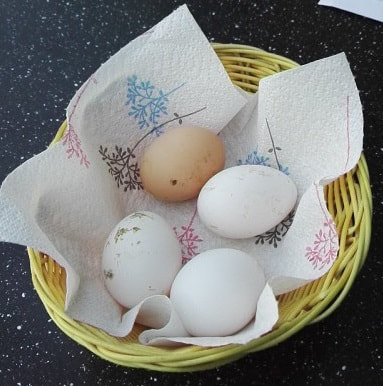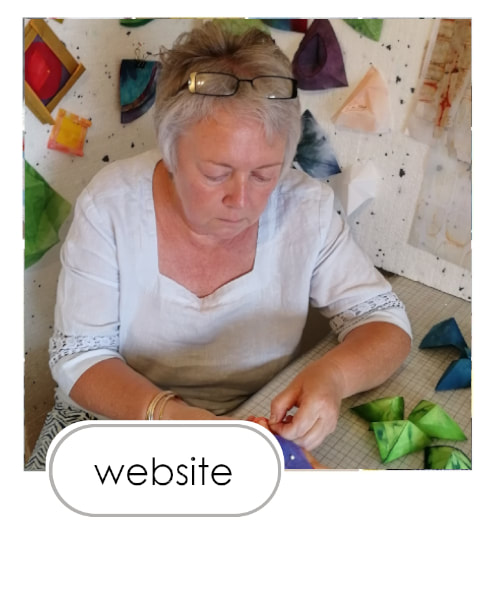|
This week has been busy with all sorts of non textile related things - perhaps the most interesting of which was the arrival of 4 ex battery hens. I've been preparing for their arrival for a few weeks, and here they are.............
They have been a fun distraction - but I have also been determined to get myself organised in the studio so I can resume dyeing fabric once again. Dyeing fabric with fibre reactive dyes (sometimes referred to as Procion MX Dyes) is pretty straightforward once all the right 'stuff' gathered together. If all the things that can be pre-mixed are made up at and at hand it is a quick process. Late last week I began by gathering various containers ready to mix and keep the different solutions I generally use when dyeing. I raided the recycling bin for a nice big bucket with a lid, a large soft drink bottle, several small bottles with lids, a few jam jars and some yoghurt type pots and put them all into an old washing up bowl. With all that ready I spent a very enjoyable day measuring and mixing the various chemicals so they are all ready when I need them. Before I carry on though, I need to say that I am not someone who dyes fabric by weighing and measuring precise amounts. I have tried to be exact, make notes, make samples, be disciplined; but after about ten minutes I have lost the plot and revert to mixing colours on the hoof with a bit of this and a few drops of that. I will never be able to exactly replicate a colour if I love it - or if I run out of fabric in that beautiful shade of crimson I dyed last week, but that's ok with me. I think I get more fun and a more exciting range of colours for my work by doing it this way. It is the way I like to do it - it isn't the only way, but I like to be a bit spontaneous and squirt colours together and try them out. But before I get to the dyes, I also need some other chemicals and solutions to be prepared. These are the 'recipes' I generally use for most of my dyeing work:
Urea Water: (also known as chemical water)
Mix together 8 tablespoons of urea in 1.5 litres of warm water in a bottle and shake until dissolved. It seems to keep indefinitely.
Soda Ash Solution: (also known as pH+)
Mix together 1 cup of soda ash and 4.5 litres of warm water in a big bucket. I give it a good stir with a wooden spoon until it is all dissolved, then put the lid on. It keeps for ever in my experience.
Sodium Alginate thickener: (also known as Manutex or kelp / seawaeed thickener)
Sprinkle 6 to 10g of sodium alginate onto 100ml liquid. You can use plain water, urea water or liquid dye, depending on the result you want. I usually make mine up with urea water. Whisk it together and leave to stand for at least 15 minutes. I put it into a jar and store it in the fridge. It keeps for a month or too before it goes stinky.
Fibre Reactive Dyes: (also known as Procion MX)
I like to make up small batches of dye (100ml to 200ml at a time) so that I have some ready to use at a moment's notice. I keep it in small bottles with the lids firmly closed. I label each colour so I know exactly which is which - sometimes the colours can be deceptive! I like to make up fairly concentrated dyes so I can dilute them if necessary. Some people believe the dyes 'go off' or lose their oomph once mixed, but I haven't found any issues with dyes I have made up and used even a month or so later. So long as there is no soda ash in the dye mixture they seem to last at least a few weeks - if not longer. I use 1 heaped teaspoon of dye powder and 2 teaspoons of salt for every 50ml of warm liquid for my concentrated dyes. The liquid is either urea water or plain water. It needs a lot of stirring to get the dye powders fully mixed and sometimes not all the powder will go into solution. I find yellow to be particularly difficult. If that is the case I usually use just plain water and which is just off boiling point. I dissolve the salt in that first, then allow it to cool a little until it is hand hot. Then I add the yellow dye powder and stir and stir and stir. Eventually most of the dye powder goes into suspension, but often settles out once the dye stands. I just give it a huge shake before using and that usually does the trick. Any tips on dealing yellow are much appreciated!!!
SAFETY FIRST:
1. Although not all the chemicals require you to wear gloves and/or a mask whilst you are handling them I find it is just easier to put them on whilst working with the various powders and not worry about forgetting to do so. That way you know you are covered! 2. Remember that any utensils or containers used with these chemicals should never be used for food use. Get yourself a collection of utensils and containers that you only use for dyeing - charity shops are great places to gather such stuff. 3. Label everything really clearly with the name of the contents and date - Manutex really stinks when it goes off! With all that prepared I will be able to dye any fabric I want in just a few minutes - with no need to get everything out and mix it all up from scratch (although sometimes that is nice to do too, especially if a big batch of something is required!) And finally.............starting work on a project at last!I need some 'wood-like' fabric. In 4 pots I mixed up some of the alginate paste with dye concentrate and soda ash solution - each pot has a different colour dye. Once the soda ash goes in the clock starts ticking! Around 4 hours is the advised time you have to work with the dye, although I find the working time lasts much longer in the cool British climate! 4 big paintbrushes and some bold brush strokes later - this was the result.
I made 3 large pieces of fabric, rolled them in a huge sheet of plastic and left them to sit in a warm room overnight (called batching).
In the morning I unrolled them, rinsed them in the sink with tepid water to get rid of the excess dye and then put them into the washing machine on a hot wash. And this is how they turned out.
So, now I need to figure out what to do with them next!
But while all that was going on, look what else happened.......................................
Thanks for reading.
|
|
